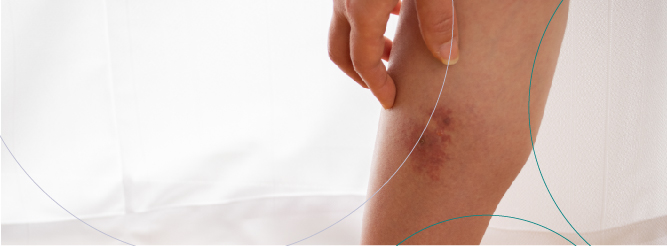
We can often take a look at our bodies and find something we’re not entirely happy with, like the shape of our nose, our weight, or skin texture, and it doesn’t get easier when we’re constantly flashed with images of how beauty or the perfect body should look like. From perfectly toned legs to flawless skin, we’ve grown accustomed to aspire to reach these beauty standards––sometimes to our detriment––without stopping to question if what we’re witnessing is actually achievable.
Thankfully, there’s been a culture shift in terms of body acceptance and we’ve grown aware enough to distinguish that what we see in magazine ads or fashion campaigns has been heavily photoshopped. We’ve also learned that we’re not alone when it comes to sharing certain conditions and that acne, stretch marks, and cellulite are far way more common than what we previously thought.
In fact, an estimated 80 to 90 percent of women have cellulite either on their abdomen, thighs, or buttocks in varying degrees
It’s also important to point out that anyone can get cellulite, no matter of their height and weight.
However, we understand that just because it’s common, it doesn’t guarantee that those who have cellulite are completely comfortable with it. Medical and technological advances have given way to new types of treatments that can reduce the appearance of cellulite on any part of the body, making the patient feel happy with their appearance and overall self esteem. Keep in mind that these skin treatments and exercise do not eliminate cellulite in its totality, and that you may need constant treatment to diminish it.
At LIMARP®, Dr. Liza María Pompa González and our team of qualified doctors help you become your happier, healthier self. Each cellulite case is different and after your first in-person consultation, we’ll be able to determine the right treatment for you, as well as other options to help you achieve the results you want. This article focuses on what causes cellulite, the different ways to treat it, and what you can do to limit its appearance.
What Is Cellulite?
Cellulite occurs when several collections of fat push against the connective tissue beneath the skin, making it appear lumpy and uneven. The puckered or dimpled skin is more common to appear on the thighs, buttocks, or abdomen, and while both men and women can get cellulite, it tends to affect women at a much higher rate. Different factors, such as age, sex, and genetics, can determine the amount of cellulite a person can get and how visible it is, as well the thickness of your skin and the amount of fat on your body. The loss of elasticity of the skin that comes with age and a person’s BMI can also make cellulite more pronounced, and although it’s more noticeable on people with obesity, it’s not uncommon for lean people to have it too.
Another sex-related cause for cellulite may be the amount of estrogen that the body produces, which could explain why women are more prone for developing the puckering of the skin, especially during adolescence or pregnancy. Other causes for cellulite may include inactivity, poor diet choices, accumulated toxins, hormone imbalances, and sudden weight gain.
While cellulite is not contagious or life-threatening, it can be categorized by its predominance in the four following ways:
- Grade 0: Your body does not have cellulite.
- Grade 1: Your skin is smooth, but there’s slight dimpling when you sit down.
- Grade 2: There is mild dimpling on your skin, regardless if you’re sitting or standing.
- Grade 3: There’s severe dimpling on your skin, as well as raised and sunken areas that make the cellulite more prominent.
Am I Eligible for Cellulite Treatment?
The short answer is yes. Having cellulite won’t bring any complications to your health, but we understand that you may feel uncomfortable with your appearance and wish to reduce it by undergoing treatment. It’s also important to point out that exercising and following a healthy diet can also help you decrease the appearance of cellulite; some of the workouts you can incorporate into your daily routine include cycling, running, and resistance training, while your diet should include more whole foods than processed food that are high on fat and cholesterol.
Once you decide you do want to partake in a cellulite treatment, your dermatologist will examine the severity of your skin and present different options that will be best for your specific case. Some of these treatments may be topical, while others are medical procedures that your doctor will have to carry out. Keep in mind that none of these treatments eliminate cellulite in its totality, but it does reduce its appearance according to type and consistency of the treatment you choose.
Now, let’s take a look at the different types of treatments available for reducing the appearance of cellulite.
Topical Treatments
It’s likely that you’ve seen countless creams in your local stores or in television ads that promise to reduce or eliminate cellulite from your body, and while some of them may work on the long run, they’re not a highly effective method for decreasing the appearance of cellulite. This doesn’t mean they won’t work, but it’s important to be mindful of the ingredients certain creams contain to ensure that what you’re buying is actually going to help you, even if the results are not as noticeable as they could be with other types of medical treatments.
So, what should we look for when choosing a topical treatment for cellulite? Products that have proven to work usually contain caffeine and 0.3 percent retinol. Creams or lotions that contain caffeine can dehydrate cells and increase blood flow which can make the cellulite appear less obvious; while products that have 0.3 percent retinol in them can help thicken the outer layer of the skin, which in time, can reduce the appearance of cellulite. Keep in mind that retinol can cause dryness, redness, and peeling of the skin, so we recommend that you test any new product on a small area first to avoid severe allergic reactions.
These products, according to a 2011 study, work better when they’re complimented by exercise and a healthy diet. It’s also important to consider that topical treatments can take at least six months to work and for the user to see noticeable results, they have to apply them daily on the parts of their body that have cellulite. This type of treatment is not as effective at reducing the more severe dimpling on the skin as other medical treatments or procedures may be; if you’ve started using creams or lotions and want to switch to a more invasive treatment, contact a dermatologist or cosmetic surgeon to see which option is best for you.
Up next, we’ll talk about the different medical treatments available and their effectiveness.
Which Medical Treatments Are More Effective?
According to several research studies, the following treatments have proven to have the best results:
Laser Treatment
There are different types of laser treatments, but it basically consists of inserting a small laser fiber underneath the skin to break up the tight bands that cause cellulite. This treatment also thickens the skin, which reduces the dimpling and uneven texture of the body where cellulite is more noticeable. It also stimulates collagen production and improves the skin’s elasticity and texture.
Although this treatment involves a tiny incision, it’s not considered as invasive and it only requires local anesthesia. The recovery time lasts from one to two days and the treatment usually lasts a year before the skin starts dimpling again.
Subcision Treatment
This type of treatment is carried out byinserting a thin blade beneath the skin to separate or break the tight bands beneath it, and it also requires local anesthesia. Subcision treatments are considered long-lasting, meaning that the results last up to three years and they become visible several days after the procedure. Side effects may include soreness and mild bruising, but most people who have received this type of treatment are content with the reduced appearance of cellulite in their body.
Non-Laser Energy Treatments
To stimulate collagen production and reduce cellulite, this type of treatment uses ultrasound, energy from radiofrequency, or infrared light to reduce fat and relax the rigid bands to make the skin firmer and smoother. These treatments are considered non-invasive and several rounds of it are needed for better results. Just like any other cellulite treatment, this one is temporary and cellulite can become apparent again after a few months.
Cryolipolysis
This is a non-invasive treatment that freezes the fat cells underneath the skin in order to remove cellulite. Once the cells are dissolved, the body absorbs them, giving the skin a smoother appearance. However, several rounds of this treatment are needed and it may take up to four months to see noticeable results.
Injectable Treatments
There’s an injectable treatment available that consists of injecting enzymes that “break down the collagen bands” that cause cellulite, reducing its appearance without the need for surgery. The amount of rounds depends on the severity and location of the cellulite on the body, but patients have seen results in as little as three months. Some side effects may include light bruising that fades over time.
These are some of the best treatments for reducing the appearance of cellulite, but it’s still a medical field that’s being constantly studied to develop more efficient solutions. If you do decide to receive one of these treatments, we recommend you go to a qualified dermatologist so that the procedure goes as smoothly and safely as possible.
Contact Us to Learn More
If you’re looking to reduce the appearance of cellulite on your body and want to know which treatment is right for you, schedule an appointment with one of our doctors. We can help determine the right treatment for you. Contact us online anytime or give us a call at (619) 373-0229.


